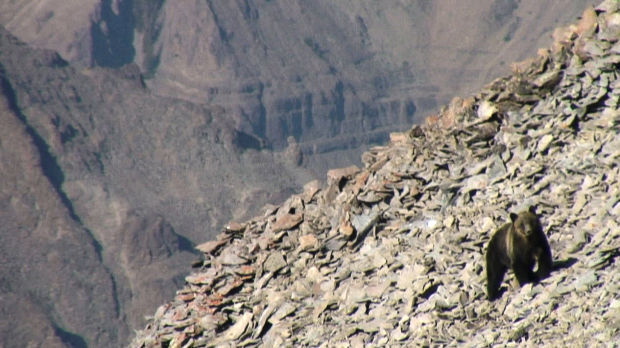More Yellowstone grizzlies eating moths
BUGS LOADED WITH FAT, PROTEIN DRAW BEARS TO HIGH COUNTRY
More grizzly bears are congregating each summer on steep rocky slopes in search of army cutworm moths in the southeastern portion of the more than 9,210-square-mile Greater Yellowstone Ecosystem.
“We’ve seen an increase in the use of these moth sites in the last three years,” Frank van Manen, of the Interagency Grizzly Bear Study Team in Bozeman, said at a recent meeting. “Certainly it’s a very intriguing food resource that we want to keep track of.”
Aerial surveys of 29 moth sites showed that the small bugs, which are packed with fat and protein, can be a powerful attractant.
The study team counted 470 grizzly bears at those 29 sites. More detailed analysis has shown 220 unique individuals just at the moth sites this year, including 19 females with cubs from this year.
Grizzly bear researchers didn’t document the sites until the mid-1980s. Since then, the team has looked more intensively to find moth areas and has confirmed 37 sites in the ecosystem, with another 16 possible locations.
“Almost 80 percent of the sites are being used,” van Manen said. “But this is not a resource being used by every bear in the ecosystem.”
Browsing bears
A recent study showed that grizzly bears have an incredibly varied diet. The big bruins, which are still listed as an endangered species in the Greater Yellowstone Ecosystem, chow down on everything from dandelions to ants.
An analysis of grizzly scat in Yellowstone National Park showed 266 different types of plants and animals.
Concern about what grizzly bears eat is high because once-plentiful natural sources of protein, like cutthroat trout and whitebark pine nuts, have declined.
The mortality of whitebark pine trees alone was 75 percent of almost 200 trees surveyed by the study team since 2002, although that decline seems to have leveled off, van Manen said.
Cutthroat trout are slowly rebounding in Yellowstone Lake, but only after intensive netting of non-native lake trout, which feed on the smaller cutthroat trout.
With grizzly bears in the ecosystem proposed for delisting by the U.S. Fish and Wildlife Service, ensuring that the bears have enough to eat is paramount in that decision.
The Fish and Wildlife Service director could hand down a delisting decision right away or months from now, according to Chris Servheen, the agency's grizzly bear recovery coordinator.
Many bear biologists insist that grizzly bears are adaptive enough to find different food sources, even if whitebark and trout numbers are down.
Some environmentalists argue just the opposite. If the bears are delisted, the issue will likely be contested in court.
Moth candy
One study of Glacier National Park grizzlies estimated that a bear could consume up to 40,000 moths a day, equal to an amazing 20,000 calories.
So although small — they have a wingspan of only 1.5 to 2 inches — the light gray moths pack a huge caloric punch.
These are the same moths that often show up around porch lights in the spring or flutter out from under cars as they drive down the street. A common name for them is miller moths.
The bugs got their army name because the larvae, caterpillars, often move in large swarms, like an army, to reach food sources.
Some grizzly bears’ use of cutworm moths shows just how adaptive the big animals can be when it comes to finding food. The insects fly west to high alpine areas in late June to feed at night on the nectar of flowers.
During the day, the moths hide under rocks on talus slopes, where the bears root them out in the mornings and evenings.
By September, or following the first snow, the moths leave to lay their eggs at lower elevations in the Great Plains, where they are considered an agricultural pest because they favor alfalfa and winter wheat fields.
Concerns that the bugs may carry toxic levels of pesticides that would build up in grizzly bears were ruled out in one study.
Despite a growth in the number of bears traveling to the moth sites, van Manen said, they are still “kind of a regional resource."
“There aren’t bears traveling over there,” van Manen said. “And there are resident bears not using the moth sites. The use of these resources is very dynamic.”










